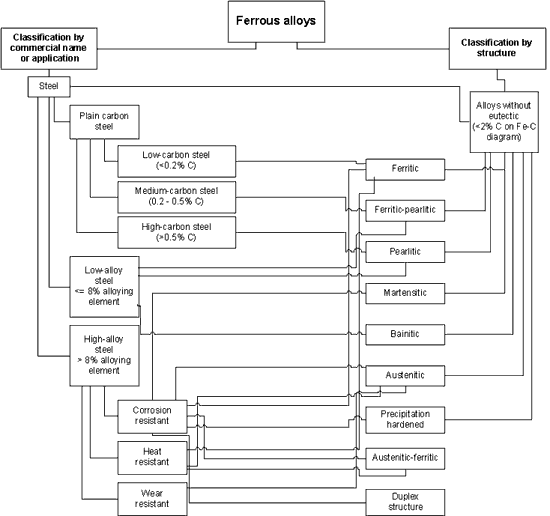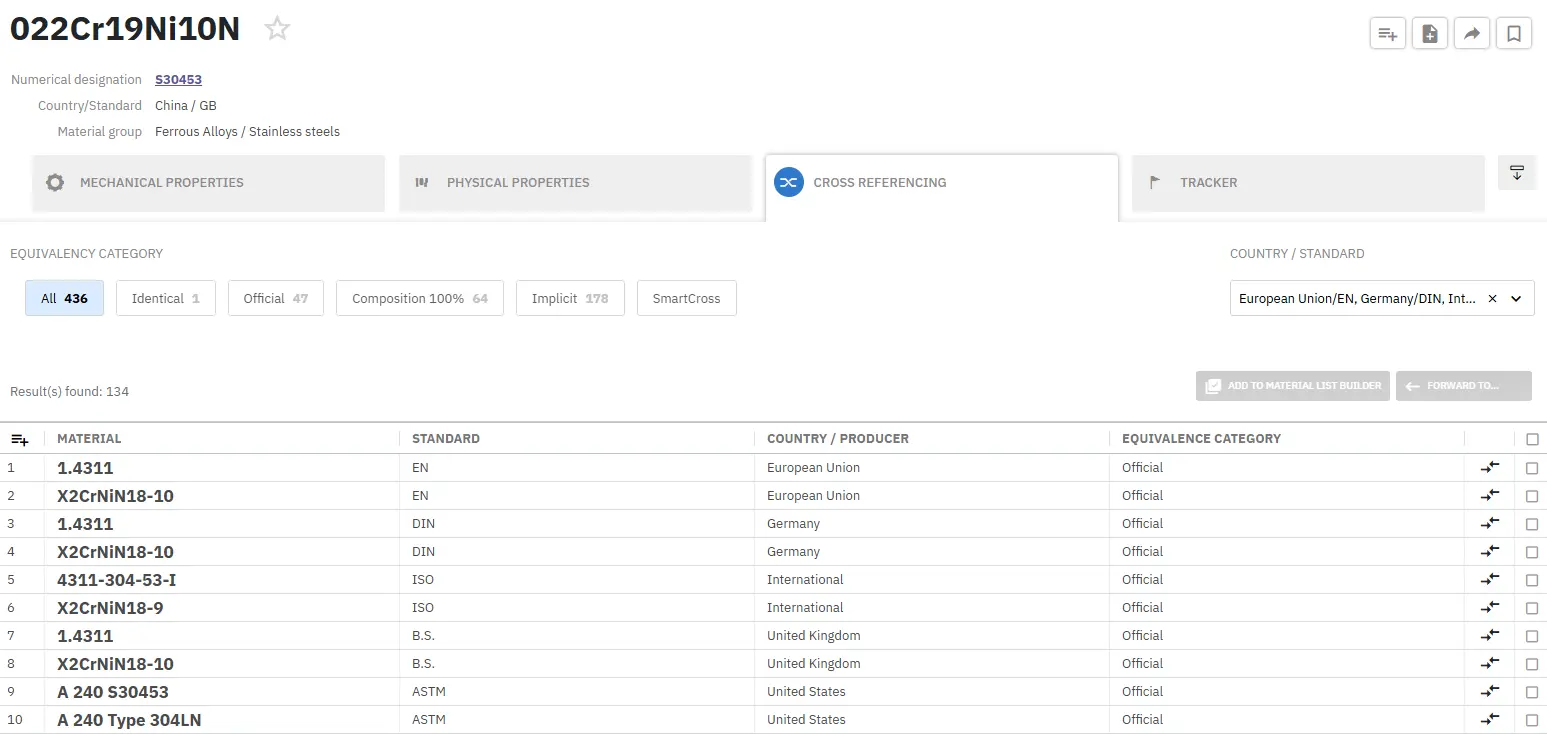Classification of Carbon and Low-Alloy Steels
Abstract
The American Iron and Steel Institute (AISI) defines carbon steel as follows:Steel is considered to be carbon steel when no minimum content is specified or required for chromium, cobalt, columbium [niobium], molybdenum, nickel, titanium, tungsten, vanadium or zirconium, or any other element to be added to obtain a desired alloying effect; when the specified minimum for copper does not exceed 0.40 per cent; or when the maximum content specified for any of the following elements does not exceed the percentages noted: manganese 1.65, silicon 0.60, copper 0.60.
What is Carbon Steel?
Carbon steel, as defined by the American Iron and Steel Institute (AISI), is steel where no minimum content is specified for alloying elements such as chromium, cobalt, molybdenum, nickel, titanium, tungsten, vanadium, or zirconium. The specified minimum for copper should not exceed 0.40%, and the maximum content for manganese, silicon, and copper are 1.65%, 0.60%, and 0.60% respectively.
Methods of Classifying Steel
Steel classification can depend on several factors:
- Composition: Carbon, low-alloy, or stainless steel.
- Manufacturing Methods: Open hearth, basic oxygen process, or electric furnace methods.
- Finishing Method: Hot rolling or cold rolling.
- Product Form: Bar plate, sheet, strip, tubing, or structural shape.
- Deoxidation Practice: Killed, semi-killed, capped, or rimmed steel.
- Microstructure: Ferritic, pearlitic, or martensitic.
- Strength Level: As specified in ASTM standards.
- Heat Treatment: Annealing, quenching, tempering, or thermomechanical processing.
- Quality Descriptors: Forging quality and commercial quality.

Figure 1. Classification of different steels
Types of Carbon Steel
Low-Carbon Steels (Up to 0.30% Carbon)
Low-carbon steels are the most common, making up over 85% of steel production in the U.S. They typically have less than 0.10% carbon and up to 0.4% manganese. These steels are highly formable and are used in applications such as automobile body panels, tin plates, and wire products. Higher carbon content steels within this category, with up to 0.30% carbon, are used for structural plates and sections, stampings, forgings, seamless tubes, and boiler plates.
Medium-Carbon Steels (0.30% to 0.60% Carbon)
Medium-carbon steels have carbon content ranging from 0.30% to 0.60% and manganese content from 0.60% to 1.65%. Increasing the carbon content to around 0.5% with higher manganese allows these steels to be quenched and tempered. Applications include shafts, axles, gears, crankshafts, couplings, and forgings, as well as rails and railway wheels.
High-Carbon Steels (0.60% to 1.00% Carbon)
High-carbon steels contain between 0.60% and 1.00% carbon, with manganese contents ranging from 0.30% to 0.90%. These steels are typically used for spring materials and high-strength wires.
Ultrahigh-Carbon Steels (1.25% to 2.0% Carbon)
Ultrahigh-carbon steels are experimental alloys with carbon content between 1.25% and 2.0%. These steels undergo thermomechanical processing to achieve a microstructure consisting of ultrafine, equiaxed grains of spherical, discontinuous proeutectoid carbide particles.
High-Strength Low-Alloy (HSLA) Steels
Characteristics and Composition
High-strength low-alloy (HSLA) steels, also known as microalloyed steels, are designed to provide improved mechanical properties and greater resistance to atmospheric corrosion. They typically have low carbon content (0.05% to 0.25%) to ensure adequate formability and weldability, with manganese content up to 2.0%. Small amounts of elements such as chromium, nickel, molybdenum, copper, nitrogen, vanadium, niobium, titanium, and zirconium are used in various combinations.
Types of HSLA Steels
- Weathering Steels: Known for superior atmospheric corrosion resistance.
- Control-Rolled Steels: Hot rolled according to a specific schedule to develop a fine equiaxed ferrite structure.
- Pearlite-Reduced Steels: Strengthened by fine-grain ferrite and precipitation hardening with low carbon content.
- Microalloyed Steels: Contain small additions of elements like niobium, vanadium, and titanium for grain refinement.
- Acicular Ferrite Steel: Very low carbon steels with sufficient hardenability to transform to a high-strength acicular ferrite structure.
- Dual-Phase Steels: Feature a microstructure of ferrite with small regions of high-carbon martensite, providing high strength and superior formability.
Additional Elements
Small additions of calcium, rare earth elements, or zirconium are sometimes added for sulfide inclusion shape control.
Low-Alloy Steels
Definition and Composition
Low-alloy steels are ferrous materials with superior mechanical properties due to the addition of elements such as nickel, chromium, and molybdenum. The total alloy content ranges from 2.07% to just below that of stainless steels (minimum of 10% Cr).
Classification Criteria
Low-alloy steels are classified based on:
- Chemical Composition: Nickel steels, nickel-chromium steels, molybdenum steels, chromium-molybdenum steels.
- Heat Treatment: Quenched and tempered, normalized and tempered, annealed.
Major Groups of Low-Alloy Steels
1. Low-Carbon Quenched and Tempered Steels
These steels combine high yield strength (350 to 1035 MPa) and high tensile strength with good notch toughness, ductility, corrosion resistance, or weldability. Examples include HY-80 and HY-100, which are used primarily as plates and sometimes as forgings or castings.
2. Medium-Carbon Ultrahigh-Strength Steels
These structural steels have yield strengths exceeding 1380 MPa and are available as billet, bar, rod, forgings, sheet, tubing, and welding wire.
3. Bearing Steels
Used for ball and roller bearing applications, these steels include low carbon case-hardened and high carbon through-hardened steels, often covered by SAE/AISI designations.
4. Heat-Resistant Chromium-Molybdenum Steels
Containing 0.5% to 9% Cr and 0.5% to 1.0% Mo, these steels have improved oxidation and corrosion resistance, with typical applications in the oil and gas industries and fossil fuel and nuclear power plants. They are usually supplied in normalized and tempered, quenched and tempered, or annealed condition.
Instantly Find and Compare Materials from Different Standards!
Total Materia Horizon contains detailed and precise property information for hundreds of thousands of materials according to all standards worldwide, updated monthly.

Get a FREE test account at Total Materia Horizon and join a community of over 500,000 users from more than 120 countries.